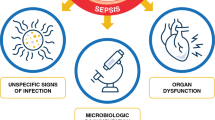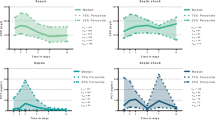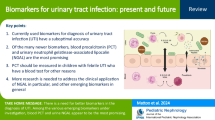Abstract
Since neutropenic patients with hematological malignancies are at high risk of contracting life-threatening infections, specific markers of infection are needed in cases of febrile neutropenia. The study presented here assessed serum concentrations of C-reactive protein (CRP), procalcitonin (PCT) and interleukin-6 (IL-6) in samples obtained from 31 febrile neutropenic patients. A total of 53 episodes were evaluated, and 18 of these were associated with positive blood culture results. Procalcitonin and IL-6 concentrations differed significantly between bacteremic and non-bacteremic episodes. Procalcitonin values were 0.22 ng/ml [interquartile range (IR), 0.15–1.9] for patients with pneumonia without bacteremia, 0.22 ng/ml (IR, 0.16–0.55) for patients with fever of unknown origin, 0.2 ng/ml (IR, 0.13–0.57) for patients with non-microbial fever and 1.8 ng/ml (IR, 0.35–5.3) for patients with bacteremia. The differences between bacteremic and non-bacteremic episodes had a P-value of 0.003 using the Mann–Whitney test. For IL-6 the median values were 301 pg/ml (IR, 152–1,879) for patients with pneumonia without bacteremia, 207 pg/ml (IR, 94–445) for patients with fever of unknown origin, 177 pg/ml (IR, 142–208) for patients with non-microbial fever and 942 pg/ml (IR, 181–2,807) for patients with bacteremia. Using the Mann–Whitney test, the differences between bacteremic and non-bacteremic episodes were P=0.006. No differences were found in CRP concentrations. Cutoff levels to distinguish between bacteremic and non-bacteremic episodes were chosen using receiver operating characteristic curves: 0.62 ng/ml for PCT and 297 pg/ml for IL-6. Negative predictive values were 84% for PCT and 70% for IL-6. The results indicate that PCT and IL-6 are more reliable markers than CRP for predicting bacteremia in patients with febrile neutropenia.



Similar content being viewed by others
References
Buchheidt D, Bohme A, Cornely OA, Fatkenheuer G, Fuhr HG, Heussel G, Junghanss C, Karthaus M, Kellner O, Kern WV, Schiel X, Sezer O, Sudhoff T, Szelenyi H (2003) Diagnosis and treatment of documented infections in neutropenic patients—recommendations of the Infectious Diseases Working Party (AGIHO) of the German Society of Hematology and Oncology (DGHO). Ann Hematol 82(Suppl 2):127–132
Link H, Bohme A, Cornely OA, Hoffken K, Kellner O, Kern WV, Mahlberg R, Maschmeyer G, Nowrousian MR, Ostermann H, Ruhnke M, Sezer O, Schiel X, Wilhelm M, Auner HW (2003) Antimicrobial therapy of unexplained fever in neutropenic patients—guidelines of the Infectious Diseases Working Party (AGIHO) of the German Society of Hematology and Oncology (DGHO), Study Group Interventional Therapy of Unexplained Fever, Arbeitsgemeinschaft Supportivmassnahmen in der Onkologie (ASO) of the Deutsche Krebsgesellschaft (DKG-German Cancer Society). Ann Hematol 82(Suppl 2):105–117
Sudhoff T, Giagounidis A, Karthaus M (2000) Serum and plasma parameters in clinical evaluation of neutropenic fever. Antibiot Chemother 50:10–19
Engervall P, Granstrom M, Andersson B, Bjorkholm M (1995) Monitoring of endotoxin, interleukin-6 and C-reactive protein serum concentrations in neutropenic patients with fever. Eur J Haematol 54:226–234
Abrahamsson J, Pahlman M, Mellander L (1997) Interleukin 6, but not tumour necrosis factor-alpha, is a good predictor of severe infection in febrile neutropenic and non-neutropenic children with malignancy. Acta Paediatr 86:1059–1064
Engel A, Mack E, Kern P, Kern WV (1998) An analysis of interleukin-8, interleukin-6 and C-reactive protein serum concentrations to predict fever, gram-negative bacteremia and complicated infection in neutropenic cancer patients. Infection 26:213–221
Heney D, Lewis IJ, Evans SW, Banks R, Bailey CC, Whicher JT (1992) Interleukin-6 and its relationship to C-reactive protein and fever in children with febrile neutropenia. J Infect Dis 165:886–890
Oberhoffer M, Stonans I, Russwurm S, Stonane E, Vogelsang H, Junker U, Jager L, Reinhart K (1999) Procalcitonin expression in human peripheral blood mononuclear cells and its modulation by lipopolysaccharides and sepsis-related cytokines in vitro. J Lab Clin Med 134:49–55
Meisner M, Muller V, Khakpour Z, Toegel E, Redl H (2003) Induction of procalcitonin and proinflammatory cytokines in an anhepatic baboon endotoxin shock model. Shock 19:187–190
Assicot M, Gendrel D, Carsin H, Raymond J, Guilbaud J, Bohuon C (1993) High serum procalcitonin concentrations in patients with sepsis and infection. Lancet 341:515–518
Chirouze C, Schuhmacher H, Rabaud C, Gil H, Khayat N, Estavoyer JM, May T, Hoen B (2002) Low serum procalcitonin level accurately predicts the absence of bacteremia in adult patients with acute fever. Clin Infect Dis 35:156–161
Svaldi M, Hirber J, Lanthaler AI, Mayr O, Faes S, Peer E, Mitterer M (2001) Procalcitonin-reduced sensitivity and specificity in heavily leucopenic and immunosuppressed patients. Br J Haematol 115:53–57
Engel A, Steinbach G, Kern P, Kern WV (1999) Diagnostic value of procalcitonin serum levels in neutropenic patients with fever: comparison with interleukin-8. Scand J Infect Dis 31:185–189
Fleischhack G, Kambeck I, Cipic D, Hasan C, Bode U (2000) Procalcitonin in paediatric cancer patients: its diagnostic relevance is superior to that of C-reactive protein, interleukin 6, interleukin 8, soluble interleukin 2 receptor and soluble tumour necrosis factor receptor II. Br J Haematol 111:1093–1102
Giamarellos-Bourboulis EJ, Grecka P, Poulakou G, Anargyrou K, Katsilambros N, Giamarellou H (2001) Assessment of procalcitonin as a diagnostic marker of underlying infection in patients with febrile neutropenia. Clin Infect Dis 32:1718–1725
Bernard L, Ferriere F, Casassus P, Malas F, Leveque S, Guillevin L, Lortholary O (1998) Procalcitonin as an early marker of bacterial infection in severely neutropenic febrile adults. Clin Infect Dis 27:914–915
Schuttrumpf S, Binder L, Hagemann T, Berkovic D, Trumper L, Binder C (2003) Procalcitonin: a useful discriminator between febrile conditions of different origin in hemato-oncological patients? Ann Hematol 82:98–103
Maschmeyer G, Beinert T, Buchheidt D, Einsele H, Heussel CP, Kiehl M, Lorenz J (2003) Diagnosis and antimicrobial therapy of pulmonary infiltrates in febrile neutropenic patients—guidelines of the Infectious Diseases Working Party (AGIHO) of the German Society of Hematology and Oncology (DGHO). Ann Hematol 82(Suppl 2):118–126
Zweig MH, Campbell G (1993) Receiver-operating characteristic (ROC) plots: a fundamental evaluation tool in clinical medicine. Clin Chem 39:561–577
Lecharny JB, Khater D, Bronchard R, Philip I, Durand G, Desmonts JM, Dehoux M (2001) Hyperprocalcitonemia in patients with perioperative myocardial infarction after cardiac surgery. Crit Care Med 29:323–325
Kettelhack C, Hohenberger P, Schulze G, Kilpert B, Schlag PM (2000) Induction of systemic serum procalcitonin and cardiocirculatory reactions after isolated limb perfusion with recombinant human tumor necrosis factor-alpha and melphalan. Crit Care Med 28:1040–1046
Kallio R, Surcel HM, Bloigu A, Syrjala H (2000) C-reactive protein, procalcitonin and interleukin-8 in the primary diagnosis of infections in cancer patients. Eur J Cancer 36:889–894
Suzaki H, Asano K, Yu M, Hisamitsu T (2003) Influence of roxithromycin on inflammatory cytokine production from nasal polyp fibroblasts in vitro. Acta Otolaryngol 123:637–642
Hirata N, Hiramatsu K, Kishi K, Yamasaki T, Ichimiya T, Nasu M (2001) Pretreatment of mice with clindamycin improves survival of endotoxic shock by modulating the release of inflammatory cytokines. Antimicrob Agents Chemother 45:2638–2642
Holzheimer RG (2003) Oral antibiotic prophylaxis can influence the inflammatory response in aortic aneurysm repair: results of a randomized clinical study. J Chemother 15:157–164
Wood GC, Boucher BA, Croce MA, Hanes SD, Herring VL, Fabian TC (2002) Aerosolized ceftazidime for prevention of ventilator-associated pneumonia and drug effects on the proinflammatory response in critically ill trauma patients. Pharmacotherapy 22:972–982
de Bont ES, Vellenga E, Swaanenburg J, Kamps W (2000) Procalcitonin: a diagnostic marker of bacterial infection in neutropenic cancer patients with fever? Infection 28:398–400
Ruokonen E, Nousiainen T, Pulkki K, Takala J (1999) Procalcitonin concentrations in patients with neutropenic fever. Eur J Clin Microbiol Infect Dis 18:283–285
Acknowledgments
This study was supported by a grant from GlaxoSmithKline, Munich, Germany, and from the Leukämie-Initiative Bonn, Germany.
Author information
Authors and Affiliations
Corresponding author
Rights and permissions
About this article
Cite this article
von Lilienfeld-Toal, M., Dietrich, M.P., Glasmacher, A. et al. Markers of bacteremia in febrile neutropenic patients with hematological malignancies: procalcitonin and IL-6 are more reliable than C-reactive protein. Eur J Clin Microbiol Infect Dis 23, 539–544 (2004). https://doi.org/10.1007/s10096-004-1156-y
Published:
Issue Date:
DOI: https://doi.org/10.1007/s10096-004-1156-y




